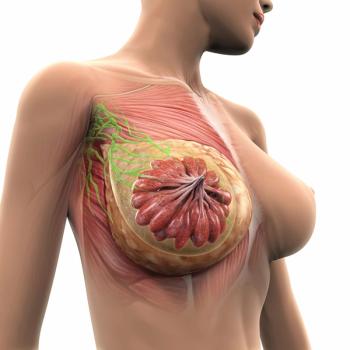
Oncology NEWS International
- Oncology NEWS International Vol 10 No 6
- Volume 10
- Issue 6
Radioactive Seeds Localize Nonpalpable Breast Cancer
WASHINGTON-The technique of radioactive seed localization presents several important advantages over wire localization for the diagnostic or therapeutic excision of nonpalpable breast cancers, said Richard Gray, MD, of the H. Lee Moffitt Cancer Center and Research Institute, Tampa, at the 54th Annual Cancer Symposium of the Society of Surgical Oncology (SSO).
WASHINGTONThe technique of radioactive seed localization presents several important advantages over wire localization for the diagnostic or therapeutic excision of nonpalpable breast cancers, said Richard Gray, MD, of the H. Lee Moffitt Cancer Center and Research Institute, Tampa, at the 54th Annual Cancer Symposium of the Society of Surgical Oncology (SSO).
Dr. Gray described a prospective randomized trial indicating that a radioactive seed technique localized tumors as effectively as the wire technique but offered greater precision and convenience.
Though the wire technique is currently the standard method of localizing non-palpable breast tumors, Dr. Gray noted, its disadvantages include the need to do localization and biopsy on the same day, the chance of displacement of the wires causing loss of localization, and the possibility of excessive dissection. Other substitute techniques also present problems, he said. Dye, for example, is inaccurate, and ultrasound techniques require surgeons to learn new skills.
The radioactive seed technique involves loading a titanium seed with 0.05 to 0.3 mCi of I125 into an 18-gauge needle. The surgeon then uses sonographic or mammographic guidance to find the lesion and places the seed at the site. Up to 5 days later, a hand-held gamma probe is used to show the skin site directly over the lesion.
Because the seed is entirely within the breast, the radiologist can use any angle without interfering with surgery, Dr. Gray noted. Furthermore, he said, precise localization through the skin allows reorientation during excision.
The final study involved 97 women, 51 of whom underwent seed localization and 46 standard wire localization, he said. No significant differences were found in pathology or in the time needed to localize or excise the lesion. Neither seeds nor wires showed detectable migration, he added. The radiologists and surgeons found no difference in ease of use, and there was no difference in patient discomfort between the two techniques.
Significantly, though, wire localization resulted in a 50% higher rate of positive excision margins than seed localization (P = .02). "This suggests that seed localization is more precise," Dr. Gray said.
He noted that radiologists "love this technique" because the seeds are closer to the lesion. The technique also indicates the lesion’s exact depth. Dr. Gray suggested that this may be related to the better margins it produces. If needed, two seeds can be used to bracket a lesion, as in wire localization.
In addition to these benefits, the seed technique also permits "better logistics," he said. Placement can take place up to 5 days ahead of excision and does not interfere with sentinel lymph node mapping. There is no excessive exposure to radiation, and seeds can be sterilized for reuse. "Nuclear medicine is involved as far as storage of the seeds," he said, but radiologists and surgeons carry out the rest of the procedure. The study did not analyze cost.
Although seed localization is still investigational, Dr. Gray believes that the technique could also prove useful at other organ sites, such as for marking colon polyps.
Articles in this issue
over 24 years ago
ACS and NCCN Issue Cancer Pain Management Guidelines for Patientsover 24 years ago
Xeloda Approved for Metastatic Colorectal Cancerover 24 years ago
Walking Improves Fatigue, Sleep in Breast Cancer Patientsover 24 years ago
Bezwoda 1985 Breast Cancer Transplant Study Fraudulentover 24 years ago
Severity of Hot Flashes Worse in Breast Cancer Survivorsover 24 years ago
Tamoxifen Prevents BRCA2, But Not BRCA1, Breast Cancerover 24 years ago
High TIMP-1 Levels May Promote Prostate Cancer Growthover 24 years ago
Barriers to Colorectal Cancer Screening Among Minoritiesover 24 years ago
Epoetin Reduces Need for Red Blood Cell Transfusionsover 24 years ago
French Researchers Discover How HIV Makes First ContactNewsletter
Stay up to date on recent advances in the multidisciplinary approach to cancer.



















































































